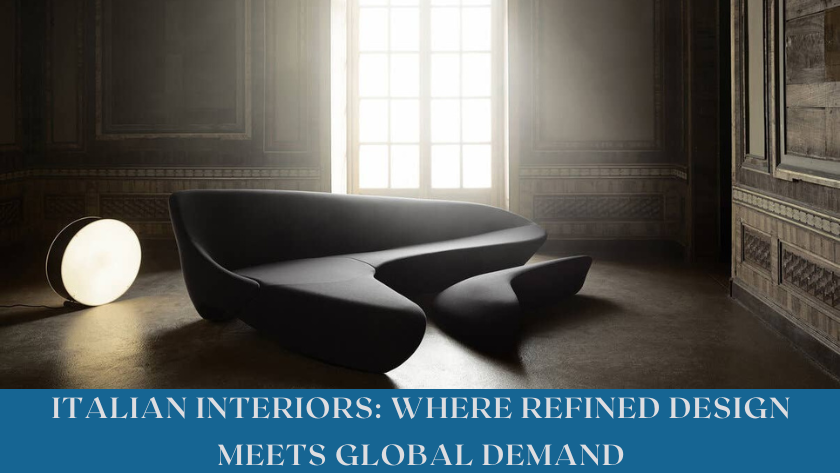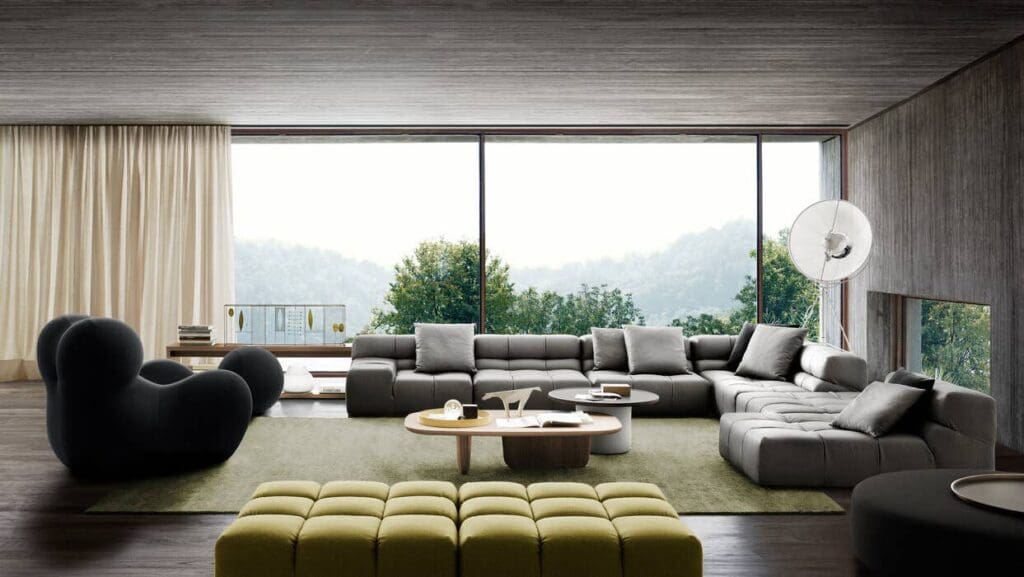Italian Interiors: Where Refined Design Meets Global Demand
- 24 April 2025
- Posted by: Narissra Ramangkool
- Category: News

Italy is globally renowned for its culinary excellence, fashion leadership, and rich artistic heritage. Yet, one of its most significant cultural and economic exports—furniture and interior design—often stands as an understated gem. As the world’s top furniture exporter and second-largest manufacturer, Italy distinguishes itself through exceptional design quality, aesthetic excellence, and a strong influence on international design trends. Merging refined aesthetics, practical functionality, and artisanal craftsmanship, Italian furniture goes beyond furnishing spaces—it defines lifestyles. While design influences the world around us, it also shapes how we occupy space, engage with materials, and perceive the environments we live in.
For international investors, particularly from Thailand where the appetite for luxury design is steadily rising, Italy’s furniture industry presents an exceptional opportunity. It is a sector driven by deep-rooted heritage, continuous innovation, and strong global demand—making it a compelling avenue for long-term investment.
A Legacy of Master Craftsmanship
Italy’s reputation for superior craftsmanship is centuries old. Regions like Brianza, just north of Milan, have long been epicenters of artisanal furniture production since the 18th century. This region alone employs over 11,000 people in furniture-related industries and accounts for more than 30% of Italy‘s high-end furniture output.
Italian artisans are admired globally for their meticulous attention to detail, intimate understanding of materials—wood, leather, metal, and glass—and dedication to traditional methods passed down through generations. For investors, this heritage signifies a reliable and quality-driven production ecosystem.
Style Meets Function—The Essence of Italian Design
Italy’s design philosophy balances minimalism with purposeful innovation. Prestigious brands such as Cassina, Poltrona Frau, FLOS, and B&B Italia exemplify this harmony, earning acclaim across Europe, the Americas, and Asia.
The global luxury furniture market was valued at USD 25.4 billion in 2022, with projections indicating a compound annual growth rate (CAGR) of 4.8% through 2030. Italian brands are key drivers of this expansion, consistently sought after by affluent consumers and discerning designers alike. For Thai and foreign investors, especially those active in real estate and hospitality, integrating Italian design into high-end developments offers a competitive advantage and elevated brand perception.
Salone del Mobile: The Industry’s Premier Event
Held each year in Milan, Salone del Mobile is far more than a design fair—it is the epicenter of the global furniture and interiors industry. Recognized as the most influential event of its kind, the 2023 edition welcomed over 307,000 attendees from 181 countries, including top-tier architects, interior designers, global media, celebrities, and affluent buyers. This remarkable growth—up 15% from the previous year—speaks volumes about its continued relevance and magnetic pull.

But for investors and business leaders, the importance of Salone del Mobile goes well beyond aesthetics for reasons below:
Market Intelligence in Real Time: Salone offers immediate exposure to cutting-edge design trends, consumer behavior insights, and product innovations. It is where the future of design is unveiled—months or even years before it reaches the mainstream.
Direct Access to Industry Leaders: Investors can engage with the decision-makers behind the world’s most prestigious brands, from emerging talents to established names like Poltrona Frau, B&B Italia, and Cassina. This makes it a prime venue for sourcing partnerships, collaborations, and distribution agreements.
A Launchpad for Asian Market Integration: As demand for luxury interiors grows across Asia, especially in Thailand, Salone becomes an ideal space to align with Italian brands looking for new markets and distributors.
Prestige and Visibility: For Thai developers, retailers, or hospitality groups, being associated with brands featured at Salone elevates brand image. It signals sophistication, global reach, and alignment with the highest design standards.
In essence, Salone del Mobile is not just where the furniture world meets—it is where design-driven business begins and it is held very year in Milan. For forward-thinking Thai investors, this is more than an event. It is a competitive advantage.
The Prestige of “Made in Italy”
The “Made in Italy” label carries immense value, both culturally and commercially. According to a 2021 Statista report, Italian furniture ranks among the top three most coveted imports in markets such as China, the UAE, and the United States.
Consumers from New York to Tokyo choose Italian-made products for their timeless appeal, superior craftsmanship, and cultural sophistication. For Thai lifestyle brands and retailers, partnerships or imports from Italian designers can significantly enhance brand prestige and marketability.
Visionaries Behind the Craft
From timeless elegance to bold innovation, Italy has long been a cradle of design genius. Some of the world’s most iconic visionaries hail from this creative powerhouse:
- Gio Ponti – A master of mid-century modern, whose work still defines refined living.
- Ettore Sottsass – The revolutionary behind the Memphis Group, whose playful rebellion shook up the design world.
- Patricia Urquiola – A global force in contemporary interiors, blending emotion, form, and cutting-edge innovation.
In the heart of Italy’s Brianza region—a constellation of high-end design brands continues to shine:
- B&B Italia – Novedrate
- Flexform – Meda
- Porro – Montesolaro di Carimate
- Molteni & C – Giussano
- Zanotta – Nova Milanese
- Living Divani – Anzano del Parco
- Giorgetti – Meda
- Cappellini – Carugo
Between Milan and Brianza, in addition to production, a large part of the Italian conception, design and communication related to the furniture sector is also concentrated: designers, design studios, communication agencies are largely concentrated in Milan and Brianza, and also work for companies from the rest of Italy.
These brands are not just making furniture—they are crafting culture. With deep artisanal roots and forward-thinking design, they remain at the forefront of global interiors. For investors and collaborators, partnering with these names means joining forces with creators of trends—not followers of them.
Key Incentives for Foreign Investors in Italy’s Furniture Sector
- 1. Tax Credits for Design and Aesthetic Innovation Companies engaged in design and aesthetic development activities—particularly in sectors like furniture, fashion, and ceramics—can benefit from tax credits. These credits are intended to support the conception and realization of new products and samples, fostering innovation within the industry.
- 2. Investment Incentives in Special Economic Zones (SEZs) Italy has established SEZs, particularly in southern regions, offering tax credits for investments in new capital goods, including machinery and equipment. The tax credit rates vary by region and company size, providing up to 40% for eligible investments.
- 3. Development Contracts for Large-Scale Projects The Italian government offers Development Contracts to support substantial investment projects, including those in the furniture sector. These contracts provide financial support through grants and subsidized loans, facilitating the growth of production activities.
- 4. Support for Research, Development, and Innovation (R&D&I) Italy provides robust aid for R&D&I projects across the country. Businesses investing in research and innovation, including those complementary to manufacturing programs, can access grants and subsidized loans to advance their initiatives.
In addition to this, Italy’s 2025 Budget Law has renewed the Furniture Bonus, granting a 50% personal income tax deduction on the purchase of new furniture and energy-efficient household appliances for properties under renovation. Despite rising living costs, this incentive encourages consumers to invest in upgrading their homes—boosting demand for quality furnishings and appliances.
Strategic Beauty
As the world continues to reimagine the meaning of home, Italy stands at the forefront—offering not only beautifully crafted interiors but also a supportive ecosystem for consumers and investors alike. With strategic government incentives like the renewed Furniture Bonus and a global reputation for excellence in design, Italy’s furniture industry represents both cultural prestige and economic opportunity. For Thai and international entrepreneurs, aligning with Italian design is more than a business decision—it is an investment in heritage, innovation, and a lifestyle that transcends borders.
To navigate this dynamic landscape and seize these opportunities, it is crucial to work with reliable legal and business experts to navigate the process of establishing a presence in Italy and ensuring compliance with local regulations. For further information on local regulations, contact @ALLEGAL





